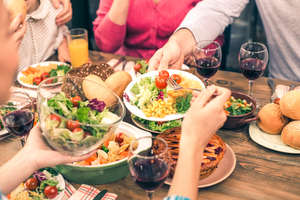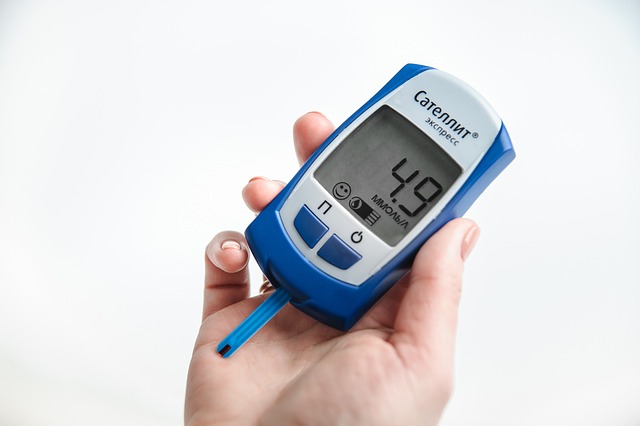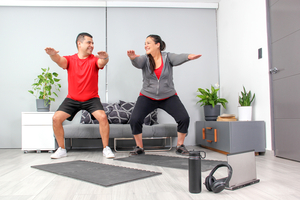Eating out is part of most people’s lives. Restaurant meals can be delicious, they give you a chance to spend time with loved ones, and they can offer a break from shopping, cooking, and cleaning. Though eating out can lead to unhealthy meals and excessive calorie consumption, it doesn’t have to. You can make changes at any restaurant to make sure your restaurant meals can help you lose weight.
Checking the Menu and Nutrition Information Beforehand
Planning ahead can help you get a restaurant meal that fits into your plan. If you know where you’re going ahead of time, check for the menu online if it’s available. Decide on what you’ll order so that you can be confident when you’re ordering. It’s easier to make a sound decision ahead of time.
You can also look for the restaurant’s nutrition information. It may be available online. If not, it may be available at the restaurant if you ask. Seeing calorie, carb, and fat counts may help guide you towards choices that are weight loss-friendly.
Challenges with Restaurant Meals
On average, portion sizes tend to be larger than portions served at home. They’re also usually higher in calories, fat, and sodium than meals and snacks prepared at home. They also can be lower in dietary fiber and vegetables. You have less control over the ingredients when someone else prepares your food.
Still, you can take steps to overcome these challenges no matter where you’re eating.
Proper Portions at Restaurants
Restaurants often serve oversized portions. Eating everything you are served can lead to consuming more calories than you need.
Here are some examples of common portions served at restaurants, and the number of servings those portions correspond to.
Strategies to Keep Portions in Check
When you reduce portions, you can reduce calories. Here are some ways to practice portion control while eating away from home.
- Ask for a doggy bag or container, and pack up half of your meal before you start eating
- Mentally divide your meal in half and stop eating when it’s half gone
- Keep a container in your car and use it to pack up half of your meal to eat later
- Split your meal with a friend
- Order from the kids or senior menu
- Order a small size compared to a medium or large
- You can also throw away half of your meal.
Even if nothing healthy is offered at the restaurant, you can stick to your weight loss plan by making portions smaller. You can always keep something healthy, like an apple or carrot sticks, in the car or in your purse to eat later if you get hungry.
Better Choices at Each Course
If you make small changes at each course, you can end up with a far healthier meal that’s more satisfying and better for weight loss.
Here are some examples.
Starters or Appetizers
If it’s okay with your tablemates, ask your server not to bring bread and butter, breadsticks and oil, or chips to start the meal. If your companions want these items, place them far from you so you can’t reach them.
Grilled shrimp, shrimp cocktail, and raw vegetables with salsa or plain are good options for starters.
In general, limit fried, breaded, creamy, and doughy appetizers. Here are some common, high-calorie choices.
- Sliders
- Wings
- Nachos
- Egg rolls
- Mozzarella sticks and jalapeno poppers
- Loaded potato skins
- Onion rings
- Fried shrimp and calamari
Salads
Some salads are nutritious choices that promote weight loss. Other salads are high in calories, fat, and carbohydrates. As long as you stay aware, you can have a filling salad that’s low in calories and packed with flavor.
A low-calorie salad has a base of greens like lettuce, spinach, arugula, or spring greens. It can also have any vegetables that the restaurant offers, such as tomatoes, cucumbers, mushrooms, or bell peppers. That’s enough if you’re having your salad as an appetizer or a side dish.
If you’re having your salad as a main course, look for a source of protein. Grilled chicken, shrimp or salmon, chickpeas, black beans or other beans, feta or other cheese, and hard-boiled eggs are all common. A small amount of walnuts, pecans, almonds, or other nuts can add protein, fiber, and healthy fats. You might also have the option of adding a whole grain like quinoa.
See if you can get vinaigrette dressing like balsamic or raspberry vinaigrette. Light Italian or ranch dressing can also be better choices than full-fat dressings like ranch, blue cheese, Thousand Island, and French. Ask for your dressing on the side. Sometimes, the portions served can be 4-8 tablespoons, but you can keep calories in check if you use only 1-2 tablespoons.
There are other possibilities for dressings if the restaurant doesn’t have any light options. Marinara sauce, salsa, dijon or yellow mustard, and light soy sauce can all serve as dressings.
Here are some ingredients that can add empty calories to salads.
- Crispy or fried chicken or fish
- Bacon, salami, and other processed meats
- Croutons, chow mein or crispy noodles, and tortilla chips or strips
- Dried fruit
Soup
Broth-based soup can help fill you up without adding many calories. Chicken noodle and minestrone soup can be good options.
Creamy and cheesy soups can be high in calories and fat. Cream of tomato, cream of chicken, broccoli cheese, corn chowder, and clam chowder are typically high in calories.
Bread bowls can add 300-500 calories to your soup.
Main Courses
Look for a menu item based on lean protein for your main course. Pasta dishes like spaghetti and meatballs, fettuccine alfredo, and lasagna can be high in carbohydrates and fat.
Here are some options to look for on the menu.
- Salmon, tilapia, or other fish
- Skinless chicken
- Veggie burger or ground turkey patties
Steak, ribs, beef burgers, and lamb chops are examples of fattier, higher-calorie choices. Breaded and fried options have extra calories, carbohydrates, and fats.
Instead, look for protein sources that are cooked without extra fats. Grilled, roasted, baked, stewed, pan-seared, and broiled choices can be lower in calories than fried options.
The nutrition information and calorie content of Items like sandwiches, burgers, and burritos can vary widely. Bread, buns, or tortillas can add 200-300 calories. Options like bunless burgers, naked burritos, or burrito bowls can reduce calories and carbs.
Here are more ways to reduce calories and make sandwiches and similar items healthier.
- Have them without mayonnaise, sour cream, or special sauce. Mustard is a good alternative
- Choose grilled chicken or cheese instead of crispy chicken, tuna salad, or fatty processed meats for a filling for sandwiches and wraps
- Choose chicken, beans, or shrimp instead of beef in burritos
- Ask for extra vegetables like lettuce, tomatoes, grilled onions, and cucumber
- Skip high-calorie fillings like rice
Sides
Many entrees come with one or two sides. Sometimes, you can select your sides. If you’re not sure, ask the server. Common vegetables include zucchini, green beans, broccoli, and seasonal vegetables. A side salad or fresh fruit may also be available.
If you want a high-carbohydrate side dish, try to find one that’s high in fiber and isn’t fried or cooked in fatty sauces. Brown rice, baked sweet potato, acorn or butternut squash, corn, and mashed potatoes can be reasonable choices.
Here are some side dishes to limit.
- French fries and sweet potato fries
- Loaded potatoes
- Mac and cheese
- Creamed spinach
- Coleslaw
- Vegetables with butter (ask for plain vegetables without sauce or butter)
Dessert
Cheesecake, brownies, chocolate cake, ice cream sundaes, and cookies are common desserts. They’re low in nutrients and high in calories. They also tend to be served in large portions. If you really want some, see if you can have just a bite of someone else’s. Another good choice is to order one or two desserts for your entire table, and have just a bite of each.
These are some other options for dessert.
- Black coffee or hot tea - choose decaf if you’re sensitive to caffeine or it’s after mid-afternoon
- Ask if fresh fruit is available
Beverages
Beverages can add hundreds of calories to your meal. Alcoholic beverages, soft drinks, milkshakes, sweet tea, and flavored coffee drinks can all be high in calories. Milk and juice have nutrients but they’re also caloric. It’s best to be aware of drinking calories at your meal, especially if you get refills throughout the meal.
Water is a calorie-free option. At a restaurant, you may get ice water. Black coffee, hot or unsweetened iced tea, and sparkling water may also be available.
How to Advocate for Yourself
It’s not always easy to find nutritious, low-calorie menu items, but it’s often possible to get a meal that works for you. It may take some planning and practice.
Ask for Help
Is the menu unclear about what the meal comes with? Are you having trouble finding something simple that you can eat? Do you want to have a meal that’s on the menu, but without certain ingredients?
Ask for help!
You’re the customer. You can ask your server for help. Here are some questions to consider asking.
- How is the chicken/fish/etc. cooked?
- Is the chicken/shrimp/etc. breaded?
- What sides does that come with?
- Is there some plain chicken/tuna/cottage cheese?
- Which toppings and what kind of dressing come with the salad?
Common Special Orders to Consider
You have the right to order what you want. Here are some modifications or special orders you can request.
- Can you please bring my burger without a bun?
- May I have the fajitas without tortillas?
- May I have a side of seasonal vegetables instead of rice?
- I’d like my pizza with light cheese, please
- Please don’t put mayonnaise on my sandwich/burger
- Can I please have the dressing/sauce on the side?
- Is it possible to get light ranch dressing instead of the dressing that usually comes with the salad?
- Do you have any fresh fruit that I can have instead of the dessert that’s listed on the menu?
The server and restaurant may or may not accommodate your requests. There could also be additional fees for things like sharing meals or swapping vegetables for the side dish listed on menus.
The Bottom Line
Eating out is a part of daily life for many people. It offers convenience, delicious flavors, and social opportunities, and it can be healthy, too. With some planning and attention to portion sizes and nutrition, you can fit restaurant meals into your healthy plan for weight loss.
Start making small changes to your nutrition today to lose weight and feel your best. Remember, your Lark coach is here to help every step of the way!
Not a member? See if you qualify today!











.webp)






